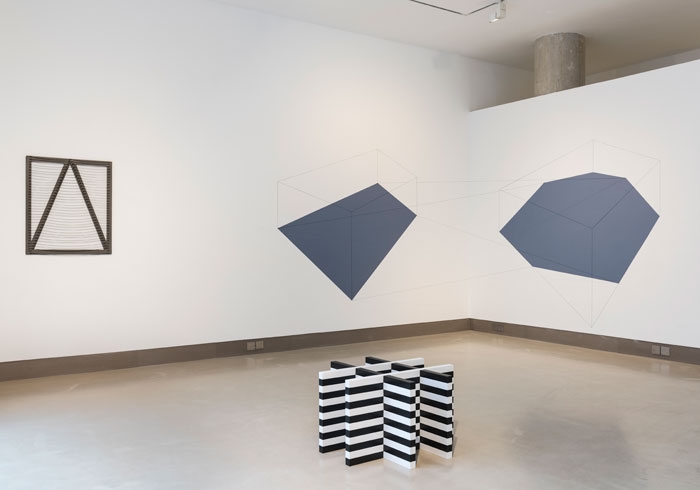White Rainbow, London, 3 May – 10 June 2017
‘Being Japanese, you are minimalist anyway,’ quipped artist Kazuko Miyamoto one day. Her witticism was taken seriously at White Rainbow gallery: it formed the premise of an exhibition in which Miyamoto’s spare artworks are paired with those of Lydia Okumura. The cool, white cube showcased work the two friends each made in New York, from the early 1970s to the mid-1980s – prints, drawings, paintings and sculptures flirting with the simplest of forms, sometimes in the prettiest of pinky-purple shades. In Miyamoto’s pencil-and-ink-on-paper Box (1975), a faint rectangular structure appears to shift, generating the illusion of depth. Okumura has similarly fetching fun with Untitled I (1980) – in which geometric purple shapes are painted onto a white wall, their edges attached to tautly suspended sections of cotton string. Blurring the lines between a two-dimensional image and a three-dimensional offering is the hallmark of both Okumura and Miyamoto’s oeuvres. Hence, if discerning where painting ends and sculpture begins is difficult here, Miyamoto and Okumura’s cross-referencing styles are just as tricky to prise apart.
While the exhibition marks the first time Okumura (born 1948, Brazil) and Miyamoto (born 1942, Japan) have shown together, they have more in common than their Japanese ancestry. Both were assistants to the founding father of Minimalism, Sol LeWitt. Both (covertly) made their own work in his studio. Miyamoto’s Stunt (181 Chrystie Street, 1981) (1982) is a vast black-and-white photographic reproduction of a performance: Miyamoto’s naked, contorted body juxtaposed against one of LeWitt’s signature giant cagelike ‘structures’. Minimalist Anyway keeps viewers guessing about the artists’ ‘real’ attitude to American art-history and LeWitt’s towering legacy. Minimalists set out to contest the heroic, subjective lone-wolf personas of their predecessors, the Abstract Expressionists, bestowing pride of place on the objective and the viewer instead. Yet, LeWitt’s mythic status in the all-male canon of 1960s American Minimalism puts paid to such aspirations. If LeWitt’s female assistants are ‘minimalist anyway’ because they are Japanese (and Minimalism is presumed to be part of their culture), where does that leave LeWitt? After all, LeWitt served in the Korean War and was stationed in Japan for a time. Are Okumura and Miyamoto’s fabrications – inspired by Japanese calligraphy and shibori (an ancient dyeing technique) respectively – reclaiming an aesthetic that was always their own? Perhaps their feminine, craft-inspired art is a sly send-up of their master’s manly, industrial-looking style?
Miyamoto’s sculptural Male I (1974) plays havoc with notions of origins – and originality. Here, dark shapes strain against a white background. Upon approaching the work, we realise that its crisscrossing network of black lines, similar to LeWitt’s pencil-and-ink drawings, are made up of pieces of string, their tips nailed to a wall. Meanwhile, what seems to be a fanlike convergence of thread is merely a crosshatch of shadows, each one as fine as a strand of hair. Does Male I symbolise a bewildering maze or an enabling network? If LeWitt casts a long shadow, does his influence represent a doorway to creativity or an aesthetic dead-end? In this doubling, troubling two-woman display, such questions remain teasingly, pleasingly unanswered.
From the Autumn 2017 issue of ArtReview Asia
